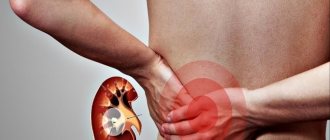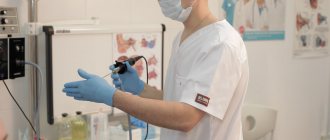Chronic kidney disease affects 10% of the world's population, and among the causes of death, kidney problems occupy 4th place after heart attack, stroke and diabetes. In the CIS countries, half of the patients die without waiting for a kidney transplant, and of the remaining 50% do not have the opportunity to receive hemodialysis.
Cost of urologist services in our clinic
| Initial consultation with a doctor with the highest category | 1000 rub. |
| Consultative appointment with a doctor based on test results and ultrasound results | 500 rub. |
| Ultrasound of the kidneys in standard mode and using Doppler techniques | 1200 rub. |
| Ultrasound of the bladder | 500 rub. |
| Ultrasound of the pelvis using Doppler techniques | 1200 rub. |
| Make an appointment by phone: 8-800-707-15-60 (toll-free) | |
| *The clinic is licensed to remove tumors |
High-quality treatment of severe pathologies prolongs the patient’s life by 20-30 years, but it is only available to the population of developed countries with high income levels. Chronic kidney disease is irreversible and patients require treatment for the rest of their lives.
What are the common congenital kidney pathologies?
The content of the article
According to statistics, in 70% of cases, serious kidney diseases are congenital or genetic. In the remaining 30%, kidney disease is caused by various external and internal causes. Congenital pathologies are caused by impaired development of the embryo in the early stages (up to 6 weeks), when the formation of internal organs occurs. Under the influence of negative factors (taking medications, ionizing radiation, toxic poisoning), the neural tube develops incorrectly, as a result of which the kidneys are formed with impaired functionality. Congenital pathologies are divided into 4 groups:
Anatomical abnormalities
They occur in various forms in 2.5% of infants. The most common is agenesis (absence of one or both kidneys) or aplasia (underdevelopment of the organ with complete loss of its functions). Agenesis is more often detected in female infants, mainly affecting the right kidney.
It is much worse if there is no left-sided organ, which is more functional than the right and is more adapted to compensatory function. Also, in 7-11% of cases, kidney doubling is diagnosed - complete or partial division of the organ, which does not in any way affect the functioning of the organ, but tends to provoke other genitourinary diseases.
Changes in tissue structure
Changes in the pyelocaliceal system, parenchyma, sinuses, and also the body of the kidney are mainly observed. These pathologies are rarely detected immediately after birth, because the newborn has enlarged renal pelvis for some time, which remove metabolic products accumulated during fetal development. Basically, changes in the structure of the kidney tissue are detected during an ultrasound examination.
Kidney failure
This is an extremely dangerous congenital disease in which the death of nephrons occurs - the structural units of the kidney through which filtration is carried out. In place of the dead nephrons, the parenchyma, a kind of sponge that filters liquid, is formed. As a result, the kidney dies and loses its ability to remove toxins.
In children, as in adults, acute renal failure leads to a sharp deterioration in well-being. After some time, the child falls into a uremic coma. In the absence of emergency assistance, the death of the body occurs. In adults, organ failure occurs against the background of polycystic disease, acute glomerulonephritis (pathological activation of the immune system when an infection enters the kidney), arterial thrombosis.
Pathological changes caused by genetic mutations
Hereditary nephropathy is a kidney disease caused by a gene mutation, which is the cause of 9% of congenital diseases of the organ. Thus, with Alport syndrome, the gene responsible for the structure of collagen in the membrane of the renal tubules, inner ear and eye is affected.
The mutation mainly occurs in boys. The disease leads to loss of function of the kidneys, vision and hearing. Chromosomal abnormalities are accompanied by multiple developmental defects.
Most often, kidney pathologies occur with trisomy of chromosome 21, partial loss of a link of chromosome 18, etc. Congenital anomalies of the organ include a horseshoe shape, displacement, hypoplasia or enlargement of the ureter, as well as multicystic disease.
How to treat the kidneys: uroseptics, citrates and drugs for chronic renal failure.
Thursday, November 25
6631
4.9
3
Content
- Causes of kidney disease
- The most common kidney diseases
- The most popular drugs for kidney treatment
- Uroseptics
- Furamag
- Nitroxoline (5-NOK)
- McMirror
- Furadonin
- Citrates
- Allopurinol
- Blémarin
- Urolesan
- Phytolysin
- Drugs for chronic renal failure (CRF)
- Kalimeit
- Renagel
Kidneys are the most important paired organ in the human body. The kidneys pump blood, clearing it of toxins, maintaining the correct acid-base balance, and reabsorbing amino acids, glucose and water. And this is not a complete list of kidney functions.
If abnormalities appear in the functioning of the kidneys, diseases may develop that are then very difficult to treat. The kidneys should be treated by a nephrologist or urologist, who will select the correct treatment regimen after examination and tests. Moreover, kidney diseases require an integrated approach: usually the doctor prescribes several drugs that affect both the causes of the problem and the symptoms, as well as restore kidney function.
Where do acquired kidney diseases come from?
The kidneys bear a tremendous burden. In an adult, they pass about 120-200 liters of fluid daily. The organ has a large margin of safety, is resistant to infections and inflammation, but sometimes a person, unknowingly, causes harm and disrupts the functioning of the kidneys.
Many diseases are asymptomatic, so preventive medical examinations should not be ignored even if you feel well. Pain syndrome appears much later, when the disease becomes chronic and changes the functional abilities of the organ. Drugs cause a serious blow to kidney health. This is especially true for self-medication, when the patient takes medications on his own without first consulting a doctor.
According to statistics, only 40% of people with respiratory viral diseases go to medical institutions, and then mainly to apply for sick leave. The remaining 60% self-medicate based on the advice of friends and online recommendations.
However, a number of medications provoke the development of kidney diseases in a completely healthy person. Moreover, these are not some special drugs, but tablets that are available in every person’s home medicine cabinet.
Drugs that kill kidneys
Potentially dangerous drugs include the following: 1. Analgesics , especially those based on acetylsalicylic acid and non-steroidal anti-inflammatory drugs (Ibuprofen, Aspirin, Diclofenac). They are used to relieve pain and reduce fever. They contain codeine, a semi-synthetic substance extracted from morphine.
The component is highly soluble in both water and alcohol, so painkillers are available in the form of effervescent tablets, capsules, mixtures, ointments and gels.
Codeine affects the nervous system and smooth muscles like morphine, only ten times weaker. Thus, codeine suppresses the excitability of the parts of the nervous system responsible for cough, and also activates the anticicertic part of the nervous system, as a result of which pain is suppressed.
Thanks to drugs containing codeine, smooth muscles relax and peristalsis decreases. However, analgesics and non-steroidal anti-inflammatory drugs have an extremely negative effect on the kidneys. The parenchyma contracts and calcifies, causing disruption of the structure of the renal tissue.
Long-term uncontrolled treatment leads to the appearance of a large lesion caused by exposure to the active substance. For this reason, after treatment of ARVI, bronchitis, pneumonia, as well as frequent use of analgesics, you should definitely check your kidneys. Changes at the initial stage can be prevented by maintaining kidney functionality. 2. Antibiotics (Methicillin, Ciprofloxacin). They help the body overcome pathogenic bacteria, but they have a significant negative property - nephrotoxicity. This is the ability of certain substances to interact with the kidney parenchyma and change its structure.
Hemodynamics change (blood pressure inside the kidney), hemolysis (breakdown of red blood cells with the release of hemoglobin), and acid balance inside the organ change.
Penicillin-based drugs cause inflammation of the glomeruli. Antibiotics interfere with renal circulation, causing ischemia of the organ.
Aminoglycosides (Gentamicin-K, Streptomycin) are highly effective in the fight against gram-negative microorganisms (chlamydia, gonococci, spirochetes), but in combination with diuretics (diuretics) they cause kidney failure and are fatal. 3. Antiviral drugs (Acyclovir, Tenofovir). They are used in the treatment of herpes, HPV, AIDS, and other viral diseases. However, the active substances are extremely difficult to remove from the kidneys, so taking antiviral medications should be accompanied by drinking plenty of water. Drugs that lower blood pressure (Amlodipine, Torsemide, Captopril, Atenolol). Drugs for hypertension lead to vasodilation, and this in turn leads to the expansion of efferent arterioles - small arteries located in the walls of smooth muscles. This leads to an increase in intrarenal pressure.
Long-term use of large amounts of drugs for high blood pressure leads to kidney infarction and complete damage to the organ. 4. Psychotropic drugs . They affect the brain and central nervous system, and the situation is aggravated by the need for lifelong medication for mental disorders. People with this problem need to have their kidneys checked regularly, because psychotropics provoke the formation of cysts in the kidneys.
Anticonvulsants can also cause chronic urinary tract disease.
Renagel
This drug is prescribed for kidney failure, when it is necessary to reduce the level of phosphorus in the blood. "Renagel" is used both for the prevention of increased phosphorus in patients on hemodialysis and for treatment. The medicine can also be taken by patients who do not have kidney failure, but who have a high risk of bone problems and elevated phosphorus levels (dysfunction of the parathyroid glands, vitamin D overdose, Addison's disease). Renagel helps people with chronic kidney failure stop bone destruction. The drug does not increase calcium levels in the blood. Side effects include: headache, nausea and vomiting, decreased blood pressure. "Renagel" is contraindicated in children under 18 years of age, with inflammatory bowel diseases and obstruction.
Renagel
Genzym, USA
- prevention of hyperphosphatemia in adult patients with renal failure undergoing hemodialysis;
- hyperphosphatemia in adult patients on hemodialysis; - as part of complex therapy aimed at preventing bone damage in connection with kidney disease and including calcium supplements, 1,25-dihydroxyvitamin D3 or one of its analogues. from 7277
386
- Like
- Write a review
Pyelonephritis: who does it threaten and who is at risk?
Pyelonephritis is an inflammation of the kidney parenchyma caused by the activity of pathogenic bacteria. The disease affects the entire pelvicalyceal region, it has a tendency to recur and occurs mainly in young people.
Pyelonephritis is found in 1% of the world's population, and in the fair half of humanity it occurs 6 times more often than in males. In its acute form, the disease is diagnosed in 13% of patients, and in 35% a purulent form is observed.
83% of people who have once had pyelonephritis experience a second relapse, and in 58% the disease becomes chronic. In 80% of cases, the causative agent of infection leading to inflammation of the pyelocaliceal system is Escherichia coli, and in other cases it is staphylococcus.
In women aged 15-40 years, pyelonephritis is a complication of cystitis, as a result of which pathogenic microflora passes through the urogenital tract.
Pyelonephritis itself is not dangerous; it does not lead to organ failure or death. However, the greatest danger is posed by the consequences of pyelonephritis - sepsis, which occurs in 10% of cases, and impaired renal function (42% of all relapses).
Who suffers from pyelonephritis and why?
- At autopsy, every 5th elderly patient had kidney damage as a result of pyelonephritis, but did not know about his disease.
- The number of pregnant women diagnosed with kidney inflammation has increased 5-fold over the past 20 years.
Pyelonephritis is exclusively bacterial in nature, i.e. its causative agent is pathogenic microflora. It is not necessary that it came from outside. Most often, the provocateur is one’s own opportunistic microorganisms, which have gained strength due to weakened immunity or other factors. Bacteria enter the bladder from the intestines or genitals, as well as through the blood and lymph. The disease affects not only adults, but also children under 7 years of age. The risk group includes children prone to frequent colds, acute respiratory viral infections, intestinal infections and inflammatory diseases.
Suppression of immunity promotes the vital activity of pathogenic microflora, which is a provocateur of pyelonephritis. Pregnancy itself provokes the development of chronic diseases, so it is advisable to first check the kidneys, because when carrying a fetus, a huge load falls on them.
Diagnosis of pyelonephritis: diagnosis requires a comprehensive examination
Diagnosis of the disease is difficult, because in 80% of cases it makes itself felt only in acute form, when the kidney tissue has undergone changes.
The similarity of the symptoms of the initial stage of pyelonephritis with cystitis leads to an incorrect diagnosis in 30% of cases and the prescription of incorrect treatment, as a result of which pyelonephritis takes on a chronic form.
The disease develops against the background of diabetes mellitus, urolithiasis in women and prostate adenoma in men. The first symptoms of pyelonephritis are disguised as ARVI and influenza. Fever, chills, back pain, aching bones - all this should alert the patient.
Only a comprehensive diagnosis, including an ultrasound examination of the kidneys, blood and urine tests will reveal the full picture of the disease. The sooner pyelonephritis is diagnosed and the sooner treatment is started, the fewer consequences there will be for human health.
Nitroxoline (5-NOK)
“Nitroxoline” is an antibacterial agent for the treatment of kidneys with antimicrobial and antifungal effects, used in patients with reduced immunity. The drug effectively fights E. coli, ureaplasma, mycoplasma, and candidiasis. At the same time, it is useless to take Nitroxoline against the background of Enterobacter, Cabsiella, and anaerobic flora. Therefore, this drug is prescribed for the treatment of the kidneys and bladder only after the corresponding pathogen has been identified. Indications: pyelonephritis, cystitis, urethritis, epididymitis, prostate adenoma or carcinoma. “Nitroxoline” does not affect the speed of reactions, and allergies very rarely develop to it. The only relative disadvantage of this drug is the need for frequent use (from 8 to 16 tablets per day).
Nitroxoline
Irbitsky Chemical Plant, Russia
Infectious and inflammatory diseases, mainly of the genitourinary tract (including pyelonephritis, cystitis, urethritis, epididymitis, infected adenoma or prostate carcinoma), caused by microorganisms sensitive to nitroxoline.
Prevention of infectious complications during diagnostic and therapeutic procedures (catheterization, cystoscopy) in the postoperative period during surgical interventions on the kidneys and genitourinary tract. from 73
635
- Like
- Write a review
Nephroptosis or why the kidney drops
Kidney prolapse occurs in 1.5% of women and 0.3% of men in the age group of 20-40 years. Prolapse of the right kidney is more often observed, because the left one is initially located higher than the right one and has a stronger ligamentous apparatus.
The organ changes its position not only vertically, but also deviates to the side or twists around its stem. This disrupts the position of blood vessels, impairs blood flow, and increases intrarenal pressure. Nephroptosis also provokes the development of pyelonephritis, because the incorrect position of the kidney contributes to stagnation of urine and the proliferation of pathogenic bacteria.
In itself, the prolapse of the organ does not affect health in any way, but a bend in the ureter with an incorrect position of the kidney provokes stagnation of urine and the formation of stones. Nephroptosis itself causes increased blood pressure, many times increasing the risk of heart attack or stroke. Kidney prolapse also provokes spontaneous abortion in pregnant women.
Causes of kidney prolapse
The following factors contribute to the development of nephroptosis:
- Pregnancy and childbirth . In unathletic women with poor physical fitness, the fixing apparatus of the kidney weakens during pregnancy and natural childbirth. In addition, the abdominal muscles also stretch, and the kidney loses support. Prolapse is facilitated by sudden weight gain and then weight loss. In general, all pregnant women, as well as mothers who have recently given birth to a baby, should especially closely monitor the health of their kidneys, because in the fair half of humanity, kidney disease worsens in the first year after childbirth.
- Weightlifting , lifting heavy objects. Fascia, sheets that attach the kidney to the peritoneum, pass into the diaphragm. They bear the main burden of keeping the kidney in the correct position.
- Overexertion caused by heavy lifting causes stretching of the ligaments holding the kidney, and it gradually drops. Nephroptosis is typical for weightlifters, construction workers, loaders, and some professional athletes. A serious consequence of the disease is arterial hypertension, which cannot be treated with conventional drugs.
- Sharp weight loss . This problem often arises among teenage girls who have complexes about their appearance and go on strict diets. Metabolism at a young age is good, so the results of the diet are noticeable.
If an adult, due to age-related metabolic characteristics, cannot quickly lose weight, then teenagers are able to lose up to 10 kg per month, which will have the worst impact on the condition of the kidneys.
The organ is located in a fatty capsule, which protects from cold and mechanical injury, and also allows the kidney to be fixed in a certain position. With a sharp decrease in weight, the fat layer becomes thinner, which causes sprains and prolapse of the organ. It is not advisable to lose more than 3 kg per month, otherwise it will affect not only your general well-being, but also the condition of your internal organs.
Nephroptosis is diagnosed at the earliest stages, when health has not yet suffered much damage. Clinical examination of the kidneys is the most effective method of preventing renal pathologies.
Why do kidney stones appear?
Kidney stones are mineral-salt deposits caused by a failure in metabolic processes. They are formed when urine becomes concentrated and its constituent substances—calcium, oxalate and uric acid—crystallize.
Oxalate is an enzyme produced by the liver and also found in fruits, vegetables and chocolate. With metabolic disorders or poor diet, the amount of oxalate in the urine increases, creating the preconditions for stone formation.
Struvite stones form when an infection enters the urine. Urate stones occur when there is an increased concentration of uric acid. The prerequisites for their formation are dehydration, excess protein foods and gout. When there is an excess of the amino acid cystine, cystine stones are formed.
Basically, stone formation is of a hereditary-genetic nature. People living in countries with hot climates are more prone to stone formation, because dehydration contributes to the formation of stones. Also at risk are people with excess body weight and lovers of salty foods. According to statistics, men are more susceptible to stone formation. Among them, 13% of the male population aged 30-60 years are affected by the disease, while women are 2 times less.
Removing kidney stones is much more difficult than avoiding the crystallization process. A thorough diagnosis in the clinic will identify the disease at the initial stage and prevent further stone formation.
Furadonin
This is one of the most inexpensive and oldest medicines for the kidneys. "Furadonin" destroys microbes regardless of their concentration. This drug is weak against enterococci and fungi, but copes well with gram-positive flora, streptococci, staphylococci, gram-negative aerobes, E. coli, and shigella. Also, Furadonin should not be prescribed for Proteus. Indications: pyelitis, pyelonephritis, urethritis, cystitis, prevention of infections during urological examinations and operations. "Furadonin" is considered a weak medicine, so it is prescribed mainly for mild infectious processes without complications. The drug has an impressive list of contraindications, including: children under 6 years of age, serious liver diseases, heart failure, etc. Side effects: disorders of the nervous system, numbness of the limbs, goosebumps (in these cases, the drug should be discontinued) , drowsiness, dizziness, problems with breathing, hematopoietic system, cough, fever, joint pain. Also, during treatment with Furadonin, hepatitis, hemolysis and even fungal superinfection may develop. Therefore, if your doctor prescribes this particular drug for kidney treatment, be sure to ask him why he didn’t choose a more modern and safe drug.
Furadonin
Olaina Chemical Plant, Latvia
Antibacterial drug used for: Bacterial urinary tract infections (pyelitis, pyelonephritis, cystitis, urethritis), prevention of infections during urological operations or examinations (cystoscopy, catheterization, etc.).
from 26
5.0 1 review
789
- Like
- Write a review









